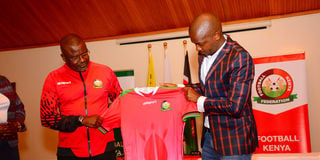Harambee Stars coaches come and go, an average of one every 16 months since 1961

Jacob Mulee (left) is unveiled by FKF President Nick Mwendwa as new Harambee Stars coach at the Safari Park hotel on October 21,2020.
What you need to know:
- Since 1961, Kenya has had a change of Harambee Stars coaches 45 times (several records do not include John “Bobby” Ogolla’s brief one-match tour to Egypt as Stars coach in 2009, but I have), that is an average of a coach every 1.31 years (about 16 months).
- At the end of the day, Harambee Stars are as good as their last game. Good luck Mulee, and the next Stars coach, and the next.
There is an important lesson I was taught in rugby, many years ago during my playing days.
This came via English coach Stuart Urquhart, who worked as Kenya Rugby Union development manager from 1997 to 2001.
In one of his visits around 1998 to KCB Sports Club where I was then plying my very amateur trade, he took us through a session, schooling us on some very clever play.
“When you have an attack move that works, keep using it, again and again until your opponent wises up. Then change it,” he told us.
Successive Kenya Football Federation, now Football Kenya Federation offices have mastered this lesson, but in an inverse way.
For them it is more of: “When you have a plan that leads to failure, keep using it until you succeed. Then change it.”
Look at how our football federation regularly hires and fires Kenya coaches amidst dismal performance by our beloved national team, Harambee Stars.
Any time a coach seems to be going somewhere, he is promptly let go for another to take his place.
The most recent was Francis Kimanzi, who parted ways with FKF on “mutual agreement” despite a positive start in the 2021 Africa Cup of Nations qualifiers that included getting a draw against African powerhouse Egypt in Alexandria, and a home stalemate with 2006 World Cup attendees Togo, and a friendly home romp against difficult Zambia at Nyayo.
In came the familiar Jacob “Ghost” Mulee.
Many people have blasted FKF president Nick Mwendwa for his decision to fire Kimanzi, whatever other way the federation my term the surprising parting of ways, but let the aggrieved, long suffering fans hold their peace.
Mulee’s astonishing entry (or is it reentry?) starkly illustrated the modus operandi of our football chiefs as far back as I can remember.
One particular incident comes to mind. When Maina Kariuki swept to the top FKF seat in 2000, he promised Kenyan football fans a Christmas gift and duly delivered with an out-of-blues announcement that the once hugely popular Reinhard Fabisch (God rest his soul) had been hired as Harambee Stars coach, for a third stint.
Fabisch’s return was unexpected but pleasantly received.
Last week, days after his reelection, didn’t Mwendwa announce the appointment of Mulee as Harambee Stars coach? Typical federation management move.
Even so, Mulee’s return, after a decade away from competitive coaching at the elite level, was astonishing and his reception by the glory-starved Kenyan football fraternity has been decidedly muted.
I am neither going to talk about the politics behind Mulee’s appointment nor the desire of the federation to have everyone under them on a tight leash.
The prerogative of that appointment is that of the federation president, who is invariably judged by, not how much football development he has achieved per se, but how the national team has performed on the international stage. Period.
I will instead coldly compare and contrast the performance of the two men – said to be the best qualified local football coaches.
Please note that this is not a definitive guide. Without the benefit of an official record book by the federation (there is none), I am using my records, painstakingly gathered from newspaper cuttings, online reports, personal interviews and memory.
Both “Ghost” and “Kim” have been appointed Harambee Stars coaches on more than one occasion. Mulee is on his fourth stint, Kimanzi was on his third.
Mulee has featured as Harambee Stars head coach in 60 international matches, possibly a Kenyan record, while Kimanzi has handled Harambee Stars as head coach in 32 international fixtures.
Here is where the mathematics gets interesting.
Mulee boasts of a win-draw-loss record of 20-18-22. Kimanzi on the other hand has a win-draw-loss record of 15-8-9.
Mulee’s win:loss ratio stands at 10:11 while Kimanzi’s is 5:3 (or 10:6 for easier comparison)
That would mean that Kimanzi, statistically, is the more successful coach. For every one game he has won he has lost 0.6 games while Mulee has lost 1.1 games for every one won.
Mulee has both the best and worst record of the two coaches in the Cecafa Senior Challenge Cup, winning the title in 2002 in Tanzania and losing all his preliminary matches in 2010 in the same country.
Kimanzi has guided Kenya to two regional finals, in 2008 and 2012, on both occasions losing to hosts Uganda.
Kimanzi guided Kenya to their highest ever Fifa ranking position in history of 68 in 2008, but failed to secure Kenya a World Cup or Africa Cup of Nations qualification.
But Mulee shepherded Kenya to the 2004 Africa Cup of Nations after a 12-year hiatus.
You cannot begrudge them. On performance, any of them deserves the Harambee Stars head coach job, that clearly does not have a permanent owner.
Since 1961, Kenya has had a change of Harambee Stars coaches 45 times (several records do not include John “Bobby” Ogolla’s brief one-match tour to Egypt as Stars coach in 2009, but I have), that is an average of a coach every 1.31 years (about 16 months).
At the end of the day, Harambee Stars are as good as their last game. Good luck Mulee, and the next Stars coach, and the next.





